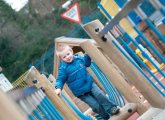We can become oblivious to the risks lurking in our setting’s rooms and outdoor areas, and when we do, accidents can occur. Wendy Bowkett explains how a simple mistake led to a rethink of her team’s practice…
Walk into a room in the early years setting where you work and really look around. Imagine it’s the first time you’ve been there. Notice the displays, storage, shelving and cupboards, labels, flooring, window coverings, chairs, tables, activities and empty space specifically used by children. Look at the noticeboards, instructions or information, storage and files for the ‘grown-ups’ using the room. Does everything look neat and tidy or a bit haphazard, full to bursting and cluttered? Are the windowsills and cupboard tops covered with items that have ‘no home’ or haven’t been put away in their rightful place? Make a few notes on your observations; perhaps what you would change, rearrange, tidy or even throw away. How often have you done just that in your work place? When working in a team situation, have you found things not in their right place? How many times have you gone to get an item and discovered that it’s not there? Has it been broken, put back in the wrong location or simply disappeared entirely? How frustrating is it to have planned an activity, knowing where everything is, only to find that the magnifying glass is not where it should be, no one seems to know where it is, and without it your activity will have to wait for another day? Finding out who used it last and where it was put away is always an exercise in frustration!
My nursery was on two floors, and each of the rooms focused on specific areas of the curriculum: a creative play room for sand, water and clay, as well as art and craft activities; an imaginative play room full of dressing up clothes and small world equipment; a physical playroom with a music corner; and a quiet room with the book corner, computer, table play and floor activities. In addition, the outdoor space had three areas for imaginative play, physical activities and pets and gardening. Every member of staff worked in rotation in each room so that their differing individual skills could bring new experiences to each area, enhancing the children’s play, exploration and experimentation.
Each person was responsible for the equipment, tidiness and general ‘look’ of the room for the fortnight they were there. Anything lost, damaged or broken would be recorded in a notebook and reported to the officer-in-charge, so that the item could be replaced or thrown away. Still things were not always as or where they should be, but at least we knew who had last been in that room and could usually tell us where they had put the ‘missing’ item. We did have a store cupboard for craft items too large or bulky to store in the creative play room.
One morning, the ‘adult’ fabric scissors were not in their place on a hook in that cupboard. These scissors were extremely sharp with very long blades, so they had to be found. They had been used the week before but had been replaced in the cupboard. The member of staff responsible swore that the student he’d had with him could confirm it. However, the student wasn’t at nursery that day, being on a threeday- a-week placement. Luckily, it was early and only two children had arrived at nursery, so all my staff were asked to look for the scissors and set up their rooms later. Even though we looked everywhere several times, the scissors were not found. Everyone was extra vigilant watching the children until we were able to ask the student if she knew where the scissors could be.
The following day, as soon as the student
arrived at the nursery, she was asked if she
had seen the large fabric scissors.
“Yes, I put them back after I cut up some scraps of fabric for collage,” she told us.
“But they’re not on the hook in the cupboard.”
“Oh, I put them in with the scissors in the pot in the play room.”
They had been under our noses all the time. The bright orange handles protruded at least 5cms above the small, blunt-ended scissors in the children’s scissors pot, but they had gone completely unnoticed by three or four members of staff.
If my colleague hadn’t mentioned that the scissors were missing, a child could have used them to seriously hurt themselves or others. How would I and my staff team have felt then?
That incident made us all sit up and think. Observation skills were of paramount importance throughout our preschool day. The fact that almost half of the staff team had looked for the scissors in the creative play room and had not found them, yet they were so obvious once pointed out to us, convinced us that maybe we needed to brush up on our skills. Perhaps, because no accidents had ever happened in our nursery, we had become a little complacent and less observant when it came to our surroundings. As I’ve always had a dislike of ‘stuff’ on windowsills (apart from a box of tissues, always handy and often needed) and cupboard tops, items were usually put away in their rightful place, but adding a student to the mix actually made us buck our ideas up! It was suggested that for the next staff meeting each member of staff would prepare a room and the garden as a hazard black spot. There could be up to six potential problems in each area, but only the person responsible for the hazards knew how many there were. We were given 10 minutes in each area (the time it usually took to set up a room for the children each session) and worked in pairs jotting down the hazards as they were spotted. The results were amazing. One hazard spotted hadn’t been staged – a trailing wire across a corner of a carpet. One staged hazard wasn’t spotted by anyone, including myself – a glass of drinking water on the shelf above the computer (which had been turned on especially to make us look at the wiring). We were all surprised at the number of potential hazards there could be in any given play area; most we were aware of, but the glass of water to drink (or spill into electrical equipment) and a stray marble made us think about our observational skills and how we were using them.
Now you’ve read about my experience, try entering the same room you observed before. Do you notice anything you didn’t previously? It’s so easy to not see potential dangers if you’ve become too familiar with your surroundings. Is there an accident waiting to happen? Don’t automatically think ‘nothing has ever happened before today, so why would it happen now?’. If my colleague hadn’t mentioned that the scissors were missing, a child could have used them to seriously hurt themselves or others. How would I and my staff team have felt then? I still think about how fortunate we were that no harm came to anyone.
It isn’t always easier to leave it to others or ignore situations, thinking it may never happen – it might. So, if you see something you’re unhappy about, talk to someone (if you don’t have the responsibility to deal with it yourself), remove it, throw it away; just don’t ignore it. Talking to colleagues about your observations may alter their perspective too…
Wendy Bowkett has worked in early years settings for over 30 years, and ran her own private day nursery for 15 years. As well as contributing to Teach Nursery, she has written a number of books for those working with 0–5-year-olds.

Supervision meeting – Getting them right in Early Years
Editors picks

Risky play – What are the benefits in Early Years?
Editors picks
